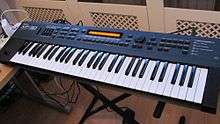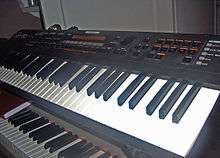Roland XP-30
The Roland XP-30 is a 61-key, 64 voice expandable synthesizer. Released in 1999, it was produced until 2002. Based on the acclaimed mid-90s JV sound engine built around a super fast 32-bit RISC processor, it is considered to be the best value-for-money of all the Roland JV and XP series synthesizers.
| XP-30 | |
|---|---|
 Roland XP-30 synthesizer | |
| Manufacturer | Roland Corporation |
| Dates | 1999 – 2002 |
| Price | £999 GBP €1499 EUR |
| Technical specifications | |
| Polyphony | 64 voices |
| Timbrality | 16-part |
| Oscillator | 4 per voice[1] |
| LFO | 2 MIDI syncable LFOs |
| Synthesis type | Sample-based synthesis |
| Filter | TVF (low pass, band, high pass, peak pass) |
| Attenuator | P-EG, F-EG, A-EG[2] |
| Aftertouch expression | Yes, channel |
| Velocity expression | Yes |
| Storage memory | 1406 patches |
| Effects | 40 effect types Reverb (8 types) Chorus |
| Input/output | |
| Keyboard | 61 keys |
| Left-hand control | Pitch bend with modulation |
| External control | MIDI In,out and thru, pedal sustain / switch |
Features and architecture
Designed for live performance, it is small, lightweight but with full-sized keys and large set of sounds (2078 when fully expanded). Keyboard is semi-weighted, with metal weights glued under the keys. It has a powerful arpeggiator with multiple patterns that can be timed by external MIDI clock (such as a sequencer or drum machine) and nine built-in drum kits. The XP-30 is aimed at expansion by giving the user 2 slots for adding Roland's own SR-JV80 range of expansion cards.
- There are 4 sliders on the XP-30 which control envelope settings, tone volumes, and 4 user-assignable parameters.
- A To Host connection for hooking the device up to a computer. This is mainly used as an alternative for a MIDI interface.
- 40-character, 2-line backlit LCD display.
- Large dial for selecting sounds.
- Connectors: Output (L/Mono, R), Phones, MIDI (In, Out, Thru), Computer interface (Mac/PC1/PC2), Control pedal, Hold pedal.
Sound banks
The XP-30 comes with 640 patches in the Preset banks plus 766 patches on the most popular SR-JV80 sound expansion cards: Session, Orchestral and Techno Collection, are included. This makes 1,406 patch sounds available, and it has two additional SR-JV80 slots. Many of the sounds were used (with higher bit rate) in later Roland Fantom series synths.
The sound banks are organized like this:
- Presets A, B, C, E - Roland's own patches, most of which came from Spectrasonics and created by renowned programmer Eric Persing. All these banks are 128 patches and 32 performances (patch combinations, same structure what Korg calls Program and Combi mode).
- Preset D is a General MIDI set.
- Expansion banks A, B, C have 256 patches each, same sound chips as in Session, Techno and Orchestral cards, but soldered permanently on the motherboard.
- Expansion Banks D and E are reserved for two SR-JV80 series cards, number of patches varies from card to card.
- User bank has 128 patch and 32 performance memories, where users can store their own created sounds or edited versions of preset sounds.
- 26 factory rhythm sets
Smart Media cards significantly increased user memory capacity, though it's not instantly accessible as older Roland RAM/ROM cards. You have to manually load one of .SVD files from card to user memory bank first, then recall sounds as usual. Though it can be done from the XP-30 front panel, it's still not like direct access to patches an old RAM and ROM cards were capable of. Despite huge memory capacity (4MB card can store 59 .SVD files, essentially a 128-patch banks), these older 5V Smart Media cards are hard to find nowadays, only on eBay.

XP series
Roland's family of XP synthesizers consists of the first released XP-10 in 1994 and XP-50 in 1995. Later joined by the XP-80 and XP-60 in 1996 and lastly the XP-30 in 1999.
References
- Corporation, Roland. "Roland - XP-30 | 64-Voice Synthesizer". Roland. Retrieved 2018-08-31.
- SynthArk, Designed by www.1234.info / Modified. "XP-30". www.synthark.org. Retrieved 2018-08-31.